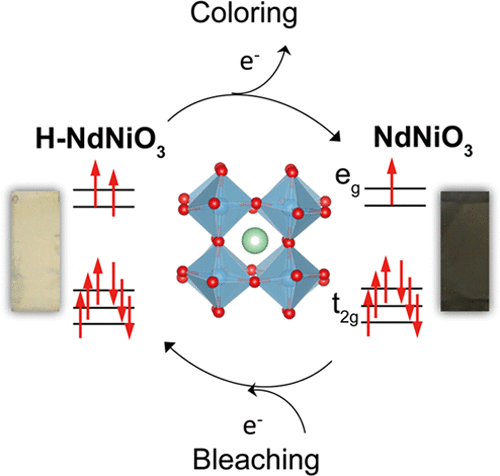当前位置:
X-MOL 学术
›
ACS Appl. Electron. Mater.
›
论文详情
Our official English website, www.x-mol.net, welcomes your
feedback! (Note: you will need to create a separate account there.)
Electrochromic Properties of Perovskite NdNiO3 Thin Films for Smart Windows
ACS Applied Electronic Materials ( IF 4.3 ) Pub Date : 2021-03-24 , DOI: 10.1021/acsaelm.1c00030 Yifei Sun 1 , Qi Wang 1 , Tae Joon Park 1 , Thomas Edward Gage 2 , Zhen Zhang 1 , Xuejing Wang 1 , Di Zhang 1 , Xing Sun 1 , Jiazhi He 3 , Hua Zhou 4 , Daw Gen Lim 1 , Chengzi Huang 1 , Haoming Yu 1 , Xuegang Chen 1 , Haiyan Wang 1 , Jianguo Mei 3 , Eric Deguns 5 , Shriram Ramanathan 1
ACS Applied Electronic Materials ( IF 4.3 ) Pub Date : 2021-03-24 , DOI: 10.1021/acsaelm.1c00030 Yifei Sun 1 , Qi Wang 1 , Tae Joon Park 1 , Thomas Edward Gage 2 , Zhen Zhang 1 , Xuejing Wang 1 , Di Zhang 1 , Xing Sun 1 , Jiazhi He 3 , Hua Zhou 4 , Daw Gen Lim 1 , Chengzi Huang 1 , Haoming Yu 1 , Xuegang Chen 1 , Haiyan Wang 1 , Jianguo Mei 3 , Eric Deguns 5 , Shriram Ramanathan 1
Affiliation

|
Semiconductors with electrically tunable band gaps are of great interest in controlling transparency to electromagnetic radiation. Thin films of perovskite nickelate NdNiO3 (NNO), a class of correlated oxides, were deposited on single-crystal (LaAlO3 (LAO)) and polycrystalline (fluorine-doped tin oxide-coated glass (FTO)) substrates by magnetron sputtering, chemical solution deposition (CSD), and atomic layer deposition (ALD). Their electrochromic behaviors were investigated using a three-electrode setup in basic (KOH solution, pH = 12) electrolyte. During bleaching/coloration process, the proton intercalation/deintercalation and simultaneous electron compensation in the NNO lattice under electrical bias led to crossover of the material between the pristine-conducting phase (Ni3+) and the strongly correlated insulating phase (Ni2+), which serves as the working principle for electrochromic (tunable opacity in the visible range) behavior. Cyclic voltammetry (CV) scans demonstrate that NNO films are electrochemically stable in basic solutions for all three film deposition methods explored here. CV scans at varying rates enabled the extraction of diffusion coefficient of protons in thin film NNO, which is ∼10–7 cm2 s–1 among all films studied. Large light transmittance modulation by bleaching and coloration was observed on films grown on both LAO and FTO substrates, suggesting its potential as an electrochromic material candidate for smart windows and optical shutter applications. Porous NNO films obtained by chemical solution deposition tend to demonstrate stronger electrochromic activity than dense films grown by sputtering or ALD.
中文翻译:

钙钛矿型NdNiO 3薄膜的电致变色性能
具有电可调带隙的半导体对于控制电磁辐射的透明度非常重要。通过磁控溅射在单晶(LaAlO 3(LAO))和多晶(氟掺杂氧化锡涂层玻璃(FTO))衬底上沉积钙钛矿型镍酸NdNiO 3(NNO)薄膜,这是一类相关的氧化物。化学溶液沉积(CSD)和原子层沉积(ALD)。使用三电极设置在碱性(KOH溶液,pH = 12)电解质中研究了它们的电致变色行为。在漂白/着色过程中,在电偏压下,NNO晶格中的质子嵌入/脱嵌和同时的电子补偿导致材料在原始导电相(Ni3+)和高度相关的绝缘相(Ni 2+),它用作电致变色(可见光范围内的可调不透明度)行为的工作原理。循环伏安法(CV)扫描表明,对于此处探索的所有三种成膜方法,NNO膜在碱性溶液中都是电化学稳定的。CV扫描以不同的速率进行,可以提取质子在NNO薄膜中的扩散系数,该扩散系数约为10 –7 cm 2 s –1在所有研究过的电影中。在LAO和FTO基板上生长的薄膜上均观察到通过漂白和着色而产生的较大的透光率调制,这表明其作为用于智能窗户和光学百叶窗应用的电致变色材料的潜力。通过化学溶液沉积获得的多孔NNO膜倾向于表现出比通过溅射或ALD生长的致密膜更强的电致变色活性。
更新日期:2021-04-27
中文翻译:

钙钛矿型NdNiO 3薄膜的电致变色性能
具有电可调带隙的半导体对于控制电磁辐射的透明度非常重要。通过磁控溅射在单晶(LaAlO 3(LAO))和多晶(氟掺杂氧化锡涂层玻璃(FTO))衬底上沉积钙钛矿型镍酸NdNiO 3(NNO)薄膜,这是一类相关的氧化物。化学溶液沉积(CSD)和原子层沉积(ALD)。使用三电极设置在碱性(KOH溶液,pH = 12)电解质中研究了它们的电致变色行为。在漂白/着色过程中,在电偏压下,NNO晶格中的质子嵌入/脱嵌和同时的电子补偿导致材料在原始导电相(Ni3+)和高度相关的绝缘相(Ni 2+),它用作电致变色(可见光范围内的可调不透明度)行为的工作原理。循环伏安法(CV)扫描表明,对于此处探索的所有三种成膜方法,NNO膜在碱性溶液中都是电化学稳定的。CV扫描以不同的速率进行,可以提取质子在NNO薄膜中的扩散系数,该扩散系数约为10 –7 cm 2 s –1在所有研究过的电影中。在LAO和FTO基板上生长的薄膜上均观察到通过漂白和着色而产生的较大的透光率调制,这表明其作为用于智能窗户和光学百叶窗应用的电致变色材料的潜力。通过化学溶液沉积获得的多孔NNO膜倾向于表现出比通过溅射或ALD生长的致密膜更强的电致变色活性。















































 京公网安备 11010802027423号
京公网安备 11010802027423号